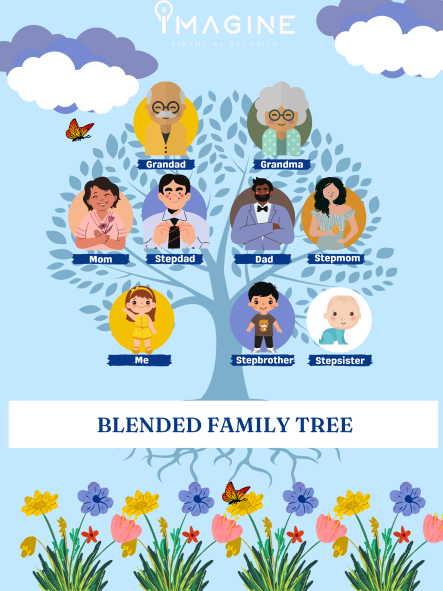
4 Retirement and Estate Planning Strategies for Blended Families in Florida
What is a blended family and why does it impact my retirement plan?
First, what is a blended family?
Simply put, a blended family involves a remarriage that comes with children from a previous marriage or relationship. Maybe you and your new spouse both have children from previous marriages. Or, perhaps you have children with an ex and a current spouse.
There are many varieties of blended families, and they are quite common. In fact, it is estimated that 40% of households with children in the United States are blended of some kind. Each blended family has unique circumstances, but retirement and estate planning strategies are more complex when it comes to dealing with blended families. I have been working with blended family retirement planning for over 13 years in our home base of Florida, as well as across the United States virtually, so let’s discuss some key issues to focus on.
How does having a blended family impact my retirement plan?
There are four major topics we will cover in this post. Keep in mind, there are other considerations you should address, and no two families are identical. You have to consider your own family dynamics, financial situation, and much more. However, this should get you started as you think about planning for retirement with a blended family.
- When should you claim Social Security?
- How will you approach your retirement income withdrawal strategies?
- How will you pay for Long-term care costs?
- Inter-generational Wealth Planning and Estate Planning

1. When should you claim Social Security?
Social Security is likely your largest source of guaranteed income in retirement. It represents 40% of all income for those 65 and older.
There is a possibility you and your spouse each have children you may want to leave assets to, and this could impact the surviving spouse’s retirement income plan. For example, if you have three children and a new spouse, you may decide to divide your estate into 1/4 for each beneficiary.
However, Social Security is one income stream that will always be available to the surviving spouse, no matter what. So, how can you maximize the lifetime benefits for you and your spouse?
If you and your spouse are both eligible for Social Security benefits, the surviving spouse will keep the larger benefit after the first spouse dies. If you have the opportunity to delay Social Security longer to maximize your benefit, this will also maximize your surviving spouse’s benefit if they were to outlive you. If you are able to delay until age 70, you will be eligible for your largest monthly benefit. If that benefit is larger than your spouse’s, it will help maximize their Social Security income in the event some of your assets were not left outright to your spouse.
Other blended family Social Security nuances....
Dependent benefits are also important.
22% of men and 18% of women have a 10 or more year age gap in a second or third marriage. Therefore, you may have remarried a younger spouse, with potentially dependent children. Or, you are remarried and had new children with your younger spouse. Nonetheless, if you are approaching retirement age, consider dependent benefits for Social Security! Dependents are defined as children under age 18 (or 19 if still in high school), or disabled before 22. These dependents could be eligible for a Social Security benefit when you start collecting yours! The benefit is equal to 50% of your primary insurance amount and is available for each dependent child and for your spouse, regardless of age!
There is a cap on the total amount paid based on your primary insurance amount, and it usually ranges between 150%-180% of your full retirement benefit. The caveat is you must begin claiming yourself in order to trigger the dependent benefits. This may result in you filing earlier than you had anticipated. Therefore, you have to run some calculations to see what is best for your situation.
Another consideration is determining your ability to collect Social Security on an ex-spouse. This will depend on how long the previous marriage lasted, and whether it ended in a divorce or premature death.
For example, if your first spouse passed away and you remarried after age 60, you could still qualify for survivor benefits on your former spouse. On the contrary, if you were remarried before 60, those former spouse’s survivor benefits will be forfeited.
For divorcees, ex-spousal benefits will be forfeited (in MOST cases) once you are remarried, but you would then be eligible for a spousal benefit from your new spouse. This is often a consideration on whether or not to legally remarry if your former spouse’s benefit would result in a significantly higher monthly benefit. But let’s be honest, if you want to marry your new partner, don’t let a few extra Social Security dollars prevent you from doing so!
2. What is a safe withdrawal strategy for retirement income?
There is a good chance you and your new spouse both had assets before you were remarried. Perhaps you and your spouse have Traditional IRAs, 401ks, Roth IRAs, and taxable brokerage accounts. However, those account values probably vary between the two of you. Furthermore, you may have slightly different estate planning goals involving children from your previous marriages.
The key is to come up with a safe withdrawal strategy from each bucket based on:
- tax characteristics
- risk tolerance
- inter-generational wealth planning or estate planning goals
- insurance coverage
- other income sources like Social Security or a pension
If you plan to leave everything to your new spouse and simply divide it evenly between all of the remaining children, the withdrawal strategy is more straightforward. However, if your children will inherit assets upon your death, how does that impact your new spouse’s retirement income plan? Will they have enough to live on throughout their life expectancy? Remember, Social Security will be reduced after the death of the first spouse, as discussed earlier.
Also, let’s say each of you has children from a previous marriage. If you are burning through your assets more aggressively to support the retirement lifestyle, how does that impact your goal to leave money to your children?

The SECURE Act changed the game with inherited IRA's/401k's.
If your children are in a higher tax bracket, you might not want to leave them your IRA or 401k outright. Your surviving spouse will likely have more favorable withdrawal options and be able to stretch this account over their life expectancy. Conversely, leaving the 401k or IRA to your children will likely trigger the new 10-year rule from the SECURE Act of 2019. This would force them to liquidate the retirement accounts fully within 10 years, likely triggering a much higher tax consequence than had you left those assets to your spouse. This is especially true if you are a Florida resident without a state income tax, and your children are residents of a state with high-income taxes (California, New York etc.). In these situations, you may want to consider a slightly higher withdrawal rate on your 401ks or IRAs, and a slightly lower withdrawal rate on your taxable brokerage accounts or Roth accounts. This way, you maximize the tax friendly assets to your children, and also maintain the tax efficiency of traditional 401ks and IRAs by leaving them to your spouse first.
There is no one-size-fits-all solution to creating a withdrawal strategy, but starting with open conversations about each other’s legacy goals for both sets of children and getting on the same page about a plan is a great first step. Once the goals are set, a safe withdrawal rate should be established. I wrote an article about this and you can read it here. The basic formula I use is; Financial Goals – Income sources – Risk Intolerance = Safe Withdrawal Rate from investments. Noticed how I used risk intolerance instead of risk tolerance. The reason is that the less risk you are willing to tolerate (the higher your intolerance score), the lower your withdrawal rate would be to accommodate for lower expected investment returns.
Should I follow the 4% rule?
Bill Bengen created the 4% rule back in the 1990’s, which back tested rolling 30 year retirement periods from 1926 to 1976. He concluded that a 4% withdrawal rate resulted in money left over at the end of retirement in all of the tested periods. You could certainly use this as a starting point, but there is much more to consider. If you want to maximize the inheritance for your children, you might need to stay close to 4% or even below it! If you don’t have a huge desire to maximize your estate to children, you might be able to inch closer to a 5% or even 6% safe withdrawal rate.
If you are comfortable with more volatility in your investments in order to maximize returns, you could potentially have a slightly higher withdrawal rate than 4%, perhaps 5%-6%. On the other hand, if you cannot withstand any volatility, supporting a 3%-4% withdrawal rate is a more realistic goal.
Finally, guaranteed income sources play a role in determining your rate of withdrawal. If you have most of your expenses covered by Social Security and/or a Pension, your rate of withdrawal required might even be 0%! In this scenario, you could choose to simply reinvest your earnings, gift to your children or even your favorite charity. On the other hand, if guaranteed income is a very small portion of your required standard of living, your rate of withdrawal might be higher than average.
All of these factors; guaranteed income, risk intolerance, and financial goals; play a role in determining what withdrawal rate to use, so be careful with using a rule of thumb from a textbook.
Using the "Guardrail" approach to withdrawals...
The higher your withdrawal rate, the greater the uncertainty. If you are more aggressive with your investments, you could expect higher returns, and maybe for a period of time a 5% or even 6% rate of withdrawal works just fine. However, what happens when the first recession hits? Or the first bear market?
This is why we like to use Dynamic Withdrawals by way of a “Guardrail Approach.” This involves reducing the rate of withdrawal during a significant downturn in stocks. Conversely, our clients can increase spending when markets are performing well. In our modeling, we have concluded that this is the best way to maximize the safe withdrawal rate, but at the same time maintain flexibility based on current economic conditions. I also wrote more in-depth about this topic in this blog post.
Should I Buy An Annuity?
One final topic to consider is whether or not you will purchase an annuity to fund retirement. There are many flavors of annuities, but the general concept is to create an income stream that you cannot outlive, much like Social Security. These products also provide some peace of mind in that the income stream is typically guaranteed, and not tied to market volatility. If you don’t have a pension, this could be a nice supplement to Social Security. Furthermore, you can name your spouse as a joint annuitant to ensure that they will continue to receive the life income if they outlive you. These products can also be beneficial in that it could allow you to take more risk with your investment portfolio, as well as impact your safe withdrawal rate, knowing that a good portion of your expenses will be covered by guaranteed income.
Many consumers believe they will be sacrificing their intergenerational wealth planning goals for their children or grandchildren by purchasing an annuity. Based on research in the industry, this might be true if you were to die prematurely. However, if you were to live to or past your life expectancy, it could actually result in an increased amount of wealth transferred. The reason is because your investments were able to ride the ups and downs of the market without being tapped into during a recession or bear market. I always recommend seeing what’s out there and comparing the rates between several carriers as they do vary greatly.
Finally, interest rates have been on the rise so far in 2022, and that trend is expected to continue at the moment. Therefore, the payout rates have become quite attractive for new annuitants, so it’s prudent to do some due diligence as you approach retirement.
3. Long-term care planning

Long-term care planning is complicated enough to prepare for during retirement. For blended families, long-term care planning is even more complex. If you and your spouse both accumulated assets for retirement, how will one pay for Long-term care costs if they are needed? Do both of you have Long-term care insurance? Or, do you plan to self insure? Are your estate planning goals the same?
Chances are, we will all need some level of custodial care at some point in our lives. The question is, how extensive is the care? And, for how long is care needed? Genworth published their annual study that indicates there is a 70% probability of needing Long-term care costs for those 65 or older. If you have children from a previous marriage, and your spouse needs care, are you going to burn through your own assets to pay for it? If you are like me, you will do anything you can to take care of your spouse and give them the proper care they need. However, if you have goals to leave money to your children, is that a risk worth NOT planning for?
On the other hand, if your spouse has children from a previous marriage and you needed care, how would he/she pay for it? Would you expect your spouse to accelerate withdrawals on their accounts unnecessarily in order to provide you care?
Should I buy Long-term Care Insurance?
If you are still young enough and healthy enough, you could consider buying Long-term care insurance. The last time I checked, it’s very rare to find a company that will cover you if you are over age 75. The sweet spot is often between 50-60 years of age, as there is a much lower decline rate and premiums are still affordable. When you get into your 60s and 70s, the decline rate goes up substantially and your premiums are quite costly.
Long-term Care Insurance is a very clean way to dedicate specific resources for this major retirement risk. Of course, nobody has a crystal ball, and you might be in the 30% that never needs care, but it’s a gamble you may not want to take.
There are also hybrid Long-term Care and Life Insurance policies that will provide a death benefit if you never use the funds for Long-term Care. Or, a reduced death benefit if you only used a portion of the Long-term Care benefit. This can provide you with some peace of mind knowing that someone will benefit from the policy. These products are much more expensive, so be prepared to write some larger checks. Also, work with a broker that can represent multiple carriers to help you shop around.
What about an annuity with a Long-term Care rider?
If you or your spouse have health issues that might preclude you from getting traditional Long-term Care, consider an annuity with a Long-term Care rider. These products do require a certain level of funding, but they are a viable option if you have a nest egg you could allocate to protect against this risk. Even Suze Orman, who is typically anti life insurance, is an advocate for these types of hybrid policies!
What about “self-insuring?”
There is nothing wrong with self-insuring, just over half of my clients decide to go this route.
If you decide to self-insure, having that discussion with your spouse about what assets to use to pay for care is critical!
If you have accounts that are more tax favorable to leave to your heirs, you may not want that account aggressively spent down for your care!
Also, consider the state you live in relative to your beneficiaries. If you live in a state like Florida or Tennessee without a state income tax, you might consider using some of your 401k or IRA to pay for care. This is especially relevant if your children are in a higher tax bracket and/or live in a state with high income taxes.
Have a plan, communicate it with your spouse, your financial planner, and your other agents so they know what to do! I also wrote an entire article on Long-term Care planning if you want to check it out here.
4. Estate Planning Basics for Blended Families
We have touched on some of the estate planning and intergenerational wealth planning challenges throughout this article. Each spouse might bring a slightly different perspective on transferring wealth. However, the amount you leave or who you leave it to isn’t the only estate planning challenge for blended families. Here are some other key points to consider:
- Who will step in to help make financial decisions as you get older?
- What about healthcare decisions?
- Who is going to be the executor of your estate, or successor trustee?
- Do you have any special considerations for any of your beneficiaries? (special needs, spendthrift concerns, son/daughter-in-law concerns, or stepchildren that you may or may not want to include)
These individuals should know what their role is, and what it is not! We’ve all heard of horror stories when someone dies without a plan, and unfortunately impacts how that person is remembered. If you have ever watched the show “This is Us,” there is a scene in the last season where Rebecca calls a family meeting with her three adult children and her second husband. This is a textbook model on how a family meeting should be conducted!
If there are different sets of children involved, consider naming one child from each “side” to participate. If it’s a successor trustee role, perhaps you can name successor co-trustees to avoid any ill will.
I certainly would make sure that a successor trustee or successor financial power of attorney is financially savvy and responsible. This does make things a bit tricky if one “side” does not have a viable option. Instead, I’ve seen where families will name the successor trustee a corporation, also known as a corporate trustee, to serve in that capacity. This way, clients don’t have to worry about anyone’s feelings being hurt because they couldn’t be trusted.
Don’t worry about giving specific dollar amounts on what you are leaving. You certainly can, but it’s not the point. The point is proactive communication and agreement from the adult children and other beneficiaries. This can really protect their relationships long term, which is far more meaningful than the dollar amounts they each receive.
If you didn’t see the episode of This Is Us, check it out here!
Should you consider a trust for your blended family?
I spoke with my own attorney and friend in detail about this. His name is Ryan Ludwick and he’s an Estate Planning specialist with Fisher and Tousey law firm based in Florida. He told me some couples come in with the idea they want to simply leave everything to one another, and then whatever is left will be divided evenly to the children. This makes things very simple, almost like a traditional family estate plan.
However, certain blended family dynamics could be solved with a trust. For example, if you want your spouse to utilize the assets for retirement if they were to outlive you, but still guarantee the remaining assets are left to your children, you might consider a trust.
A trust would essentially be set up for the surviving spouse. When you pass away, the trust becomes irrevocable (nobody can change it), and your spouse can use the assets for their care. Once the second spouse dies, the remainder beneficiaries (presumably your children) will receive the trust assets.
A few reasons why a trust could make sense are:
- The assets held in trust would not be up for grabs in the case of a remarriage.
- Potential creditor protection benefits.
- Oversight – meaning you could name a trustee to help manage the trust, in case your surviving spouse was incapacitated down the road, or if they don’t have the financial acumen.
- And of course, the terms are your terms, and cannot be altered.
Life Insurance
Life Insurance could also be a great tool for estate planning for blended families. You could set up a new policy, or change the beneficiary of an old policy, to satisfy certain estate planning goals.
For example, let’s you wanted to split your investment assets four ways at your death between children and your new spouse. Between your spouse losing one Social Security benefit and only receiving 25% of your estate, their ability to maintain financial independence could be at risk. Therefore, you could consider leaving your life insurance policy to your spouse to make them whole.
On the other hand, you may not want to leave those 401ks or IRAs to your children for reasons mentioned before. Therefore, you could elect to leave those assets to your spouse (outright or in a trust), and leave the life insurance policy to your children. The death benefit is always tax free, so this solves the issues related to inheriting retirement accounts with the new SECURE Act law.
Elective Share Rules
Ryan said to “be careful of the elective share rule for spouses.” In Florida, and many other states without community property laws, the spouse is entitled to a percentage of the estate, regardless of what your will says. For Florida, it’s 30%. So let’s say you only designate 10% to your spouse in your will, he or she could contest this in court, and would likely win.
There are legal ways to get around this by way of signing a prenuptial agreement, or having your spouse sign a waiver form. It’s just something to be mindful for, especially with blended family estate planning.
Final word
As you can see, blended families are unique in an of themselves, so cookie cutter retirement and estate planning advice doesn’t work.
There are other considerations for blended family retirement planning, and no two situations are created the equal, which is why we love helping people like you!
Book a call with us!
If you have questions or want to discuss your situation, feel free to book a 30 minute Zoom call and we would be happy to connect with you.
Subscribe to our email list!
If you liked this article, be sure to subscribe to our email list so you don’t miss out on any of our latest articles!




